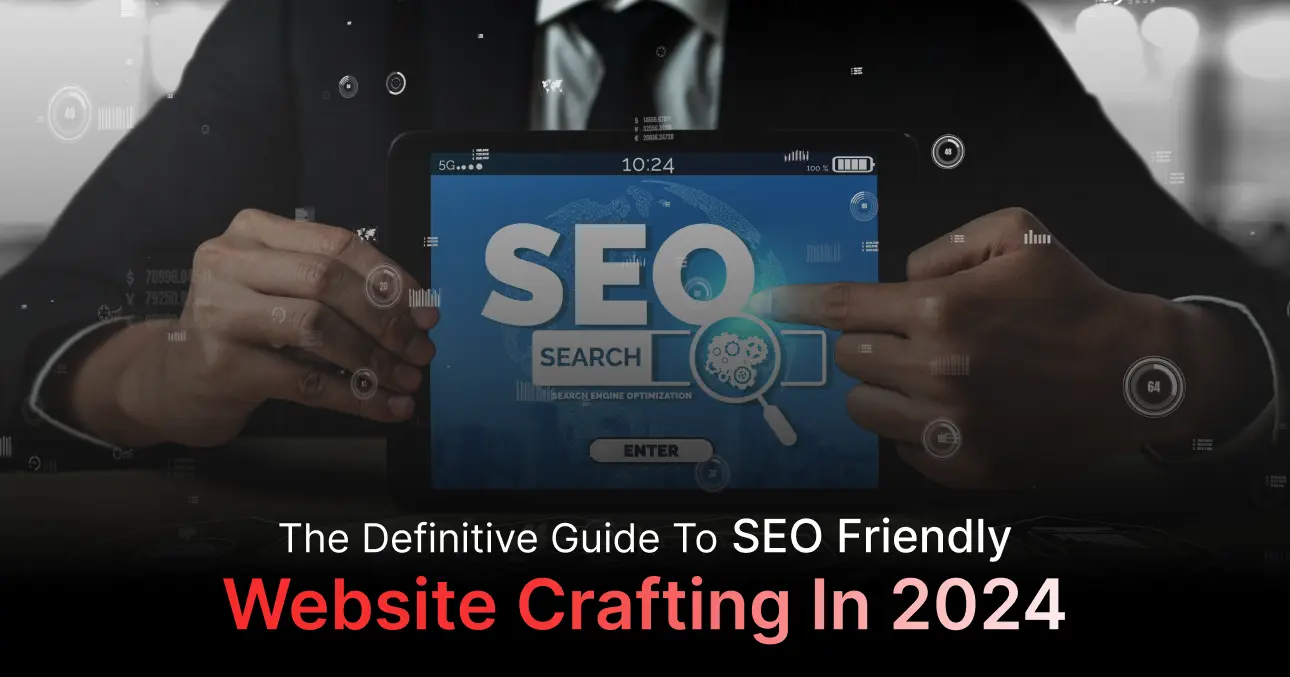The Definitive Guide to SEO Friendly Website Crafting in 2024
Welcome under the roof of an SEO! The development of a website is essential for every business. For developing a website, many things go beyond content. Only when you focus on all the areas, the goal for the website will be achieved. SEO is one of the main areas that should be focused and it is also crucial among all the others. A website should attract visitors of the website and make them comfortable in using the website, then only the visitors will revisit and end up increasing the visibility and engagement of the website. So to do so, this article is here to help you with steps to be followed to develop an SEO-friendly website.
What is an SEO Friendly website?
1. An easy URL structure is important for SEO-friendly practices. A short descriptive URL in lowercase form to get easily indexed by search engines and can also be easily remembered by regular visitors to our website. A URL consisting of the main keyword will be useful for search engine indexing.
2. All pages should have a unique meta title and description within the character size of 50 to 60 and below 155 respectively.
3. People will visit a website that is quickly loaded and provides the necessary information that they are seeking. So page speed is an important factor for SEO-friendly websites.
4. Coming to the content of the website, the website should provide unique content then only it can be indexed by search engines since search engines don't appreciate plagiarized content.
5. Optimizing images by decreasing their sizes will improve the page speed and adding alt texts for the image helps the crawlers to know more about the image.
6. Proper structure of the content is important for search engines to crawl and observe the content of the website.
7. Internal linking creates links to your other pages so that search engines can crawl to other pages of your website also.
Why is an SEO-friendly website so important?
The above information can give you a clear idea about which are all the things that can make a website SEO-friendly. So now let's dive into the importance of SEO.
Organic traffic:
When the SEO of the website is friendly for both search engines and visitors it can get the most optimum organic traffic. When the organic traffic is increased it can be the stepping stone for building a wider audience and improving lead generation. The more organic traffic the website gets, the more visitors, and the search engine page rank increases.
Brand credibility:
When the website is ranking higher in search pages, then the credibility of the website will increase which in turn results in more organic traffic. Most websites will get higher search engine page ranks because of their SEO-friendly websites, thus their trust in the audience increases. Even we people look for brands that have more credibility and trust among people. To gain that trust, the website has to be friendly not only to visitors but also to search engines.
Cost Efficient:
When the SEO practices are good and are providing more leads by organic, then there will be no need to invest in paid advertising. So it can directly help with the cutting of budgets and can improve cost efficiency in business.
Steps to develop an SEO-friendly website
1. Easy URL structure
When URL for a website, it should be descriptive, short, and simple to understand. It should also include targeted keywords so that it could be easy for crawling and indexing. Using lowercase letters and avoiding special characters would make it more readable. Focusing on these terms when creating a URL could increase your SEO practices in certain terms since it could be beneficial for both the search engines and the human visitors.
2. Meta Title and Description
For instance, if a visitor is searching for something on the search page, they will first read your title and description on the search page to get a glimpse of your website and if that is relevant to their needs they will visit your site. The title and description that are showing about your site are the Meta title and description. These should be crafted with the main keywords of our website and should be readable in a way that could explain what the website consists of. Each page of your site should have a specific meta title and description. So that it will be easy for search engines to crawl and know about that page.
-
● Meta Title should be within 50 to 60 characters containing any call to action and the brand name so that it will be informative about the content of the website.
-
● Meta Description should be within 155 characters containing the targeted keywords and a clear-cut picture of the content and brand of the website.
If you exceed the respective characters it might not be visible in the search page and could not be readable by the visitors. So it is crucial to follow these principles.
3. Use Unique website content with targeted keywords
Creating a website with unique and valuable content is the crucial factor to be noted among all other factors for developing a website. It is the helping factor in increasing the traffic and leads for the website. Website content increases visibility by ranking on relevant targeted keywords, thus people will visit your website. So that the quality and quantity of the leads will improve.
Include all the primary keywords and some secondary keywords in the content to increase the ranking factors. Use valuable content according to the user’s needs and search query.
The content of the website includes all the multimedia elements to enhance the user experience. Optimizing it with alt texts and file names will be useful to be crawled by search engines.
4. Content Structure with Increased Readability
Structuring your content is important not only in terms of readability but also for better SEO practices since both the search engine visitors and human visitors impact the SEO. Create your content with detailed headings and subheadings by giving breaks where needed. It will help the users to go through the whole content of the website. The content should be given the importance that it should be delivered in what way and in what place. Choosing and inserting images in respective places that show the exact related content will be beneficial.
5. Mobile and desktop-friendly
Creating a website that is responsive and adaptable to different screen sizes is fundamental in website design. Since there are several devices in this era of the digital world, the website should be displayed in the same manner on all devices. So testing it in various devices to know about the user experience is essential. Search engines prioritize mobile-friendly indexing. So optimizing it according to mobile devices should be ensured.
6. Internal Linking
Internal linking is the process of adding other pages of your links in other pages by using hyperlinks. This is also one of the main concepts in SEO boosting. This helps in indexing all the pages of your website by search engines. Search engines crawl all pages of your site using internal linking. This also helps search engines to know about the structure of the website. Links can be added to texts, videos, images, etc in the website's content. Using blog posts to insert links to our pages related to that blog is useful for visitors to scroll and move to other related pages on your site.
The majority of websites contain only a handful of pages that merit their position in the primary navigation. Linking to your most essential pages from the footer is an excellent method for interlinking your website in a way that prevents congestion. Footer links do not significantly impact SEO in a direct manner. However, they contribute significantly to the user experience and may even boost your website's rankings indirectly.
7. Structure of the site
It is advisable to limit the distance between the homepage and important pages to no more than four clicks. Especially large websites should be wary of this, as pages that are excessively nested may receive fewer crawling visits.
In addition add Sitemaps which are XML documents that contain a comprehensive catalogue of crawlable URLs on a given website, accompanied by essential metadata including the date of publication. By uploading this file to Google Search Console, you improve the speed and efficiency with which Google can locate your newly added pages.
8. Fast loading Webpages
Fast-loading pages helps to improve the SEO rankings and user experience. In fact, despite Google's capability to identify and index your webpages, it is aware of the fact that your site's functionality is lacking and it does not provide a satisfactory user experience. As a consequence, your website will be demoted in the search engine results. Therefore, in order to enhance a website's rankings, its navigation and access should be intuitively designed and clickable across all devices. In general, search engines scan webpages that render rapidly and provide the most gratifying user experience. Reduce the file sizes of the images to expedite loading times. By optimising HTTP requests to decrease server response time, page speed can be increased.
9. Keep your Content Updated
Technology and things are updating every second nowadays. People are expecting to explore new and updated stuff. So keeping your website content updated is also essential to grab visitors. Updating the website with new experiences and new information for the visitors will make them revisit your site. Make sure that your update attracts visitors by giving the necessary information that they are expecting. Providing correct and updated information will be more useful as it will bring more value to the website and brand name.
Make your website SEO-friendly from today!
A well-established online presence is the bedrock for substantial business expansion. Websites are the primary mediums through which businesses exhibit themselves. In the same way that each enterprise necessitates a well-functioning website, it is imperative to integrate SEO-friendly strategies in order to successfully navigate it’s path of expansion. Optimisation for search engines is the driving force behind internet marketing. Consequently, it is critical to prioritise the optimisation of your website for search engines (SEO) in order to facilitate expansion in various aspects and reduce costs associated with marketing. With any luck, this article will elucidate the development process necessary to ensure that a website is optimised for search engines. Feel at liberty to promptly execute these measures in order to expedite the growth of your organisation.
If you are seeking a dependable partner to improve the ranking of your website, your search is over with Click Box Creative Marketing Agency. We, being the preeminent SEO firm, provide exceptional marketing strategies that will significantly elevate your company. Contact our team of SEO consultants immediately to begin discussing strategies and plans that will ensure your success.
John Click
Digital Marketer | SEO Copywriter | Content Strategist
Experienced digital marketer with a proven track record in creating compelling content that not only engages audiences but also drives conversions and enhances SEO visibility. My expertise extends beyond marketing strategy to crafting persuasive narratives that resonate with your target audience. I combine data-driven strategies with captivating writing to deliver measurable results, ensuring your brand shines in the digital landscape.




 Digital Marketing
Digital Marketing


 Digital Marketing
Digital Marketing Digital Marketing
Digital Marketing



